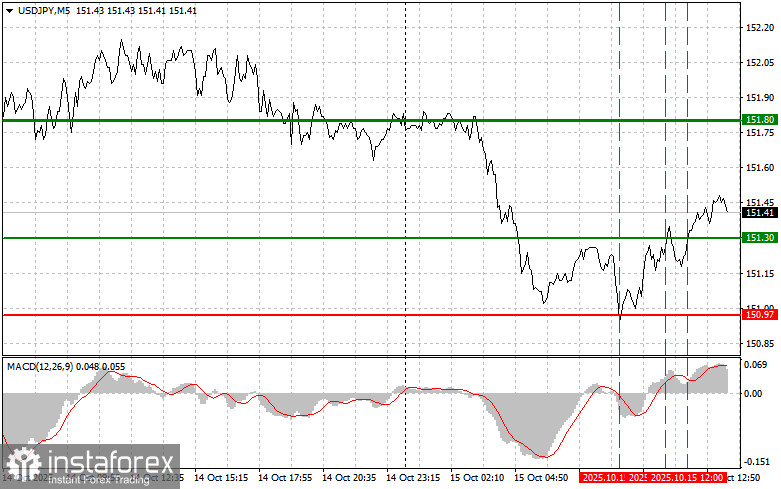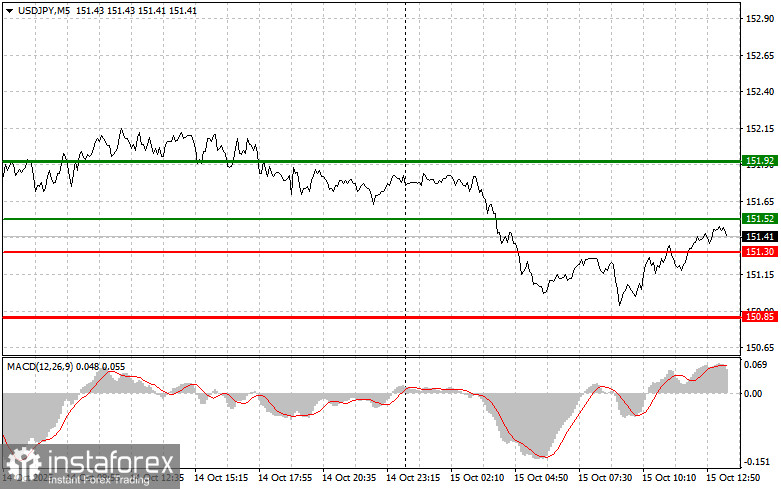Trade Analysis and Recommendations for Trading the Japanese Yen
The price test of 151.30 in the first half of the day occurred when the MACD indicator had already moved significantly above the zero line, which limited the pair's upward potential. For this reason, I did not buy the dollar. The second test of 151.30 coincided with the MACD being in the overbought zone, triggering Scenario #2 for a sell trade, but the pair never actually declined, resulting in a loss.
Today's focus is on the Empire Manufacturing report. Given the lack of any other significant statistics, this release alone may provide insight into the state of the manufacturing sector in the region. Traders are unlikely to react strongly to signs of either slowdown or acceleration in economic activity. The Empire Manufacturing Index is expected to rise slightly compared to the previous period. Afterward, market participants will shift their attention to speeches by FOMC members Christopher Waller and Jeffrey Schmid. Their remarks on the current macroeconomic situation and future prospects for monetary policy will be closely analyzed for hints of potential further interest rate cuts. However, even if their position differs from Federal Reserve Chair Jerome Powell's comments yesterday, the U.S. dollar is still likely to lose ground against the yen.
As for the intraday strategy, I will mainly rely on Scenarios #1 and #2.

Buy Signal
Scenario #1: Today, I plan to buy USD/JPY when the price reaches around 151.52 (green line on the chart), targeting growth to 151.92 (thicker green line on the chart). Around 151.92, I plan to exit buy positions and open sell positions in the opposite direction, aiming for a 30–35 point movement in the reverse direction. A rise in the pair can be expected as part of the ongoing upward trend.Important: Before buying, make sure the MACD indicator is above the zero line and just beginning to rise from it.
Scenario #2: I also plan to buy USD/JPY today if there are two consecutive tests of the 151.30 level, at the moment when the MACD is in the oversold area. This will limit the pair's downward potential and lead to a reversal upward. Growth can be expected toward the opposite levels of 151.52 and 151.92.
Sell Signal
Scenario #1: Today, I plan to sell USD/JPY after it breaks below 151.30 (red line on the chart), which will lead to a quick decline in the pair. The key target for sellers will be 150.85, where I plan to exit short positions and immediately open buy positions in the opposite direction (expecting a 20–25 point upward movement from that level). Downward pressure on the pair may return if Fed officials adopt a dovish stance.Important: Before selling, make sure the MACD indicator is below the zero line and just starting to fall from it.
Scenario #2: I also plan to sell USD/JPY today if there are two consecutive tests of the 151.52 price level, at the moment when the MACD is in the overbought area. This will limit the pair's upward potential and lead to a downward reversal. A decline can be expected to the opposite levels of 151.30 and 150.85.

What's on the Chart:
- Thin green line – entry price where you can buy the trading instrument;
- Thick green line – projected price where you can set a Take Profit or manually lock in profits, as further growth above this level is unlikely;
- Thin red line – entry price where you can sell the trading instrument;
- Thick red line – projected price where you can set a Take Profit or manually lock in profits, as further decline below this level is unlikely;
- MACD indicator – when entering the market, it is important to consider overbought and oversold zones.
Important Note
Beginner traders in the Forex market should make entry decisions with great caution. Before the release of major fundamental reports, it's best to stay out of the market to avoid sudden price volatility. If you decide to trade during news releases, always set stop-loss orders to minimize losses. Without stop-losses, you can lose your entire deposit very quickly — especially if you don't apply money management and trade with large volumes.
And remember: for successful trading, you must have a clear trading plan, like the one presented above. Making spontaneous trading decisions based on the current market situation is an inherently losing strategy for an intraday trader.





















